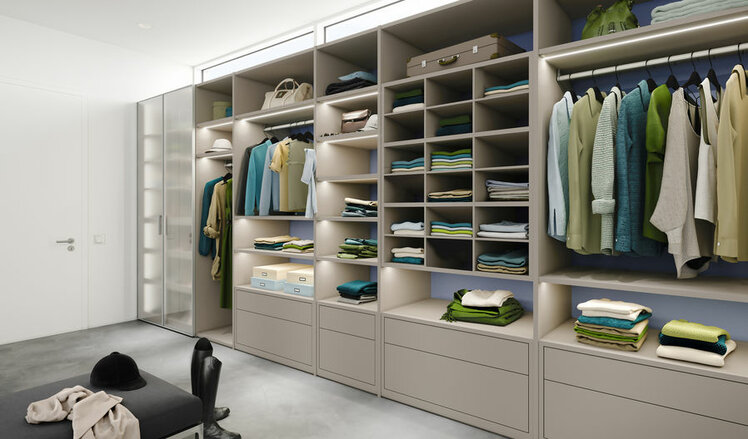A walk-in wardrobe is much more than a particularly generous form of clothes storage: for many, it is one of the highlights of individual living, a special extra in room design that appeals in many different ways. Because a walk-in wardrobe combines numerous advantages - from simple functionality to visual aspects. And the topic is no longer only relevant for women: more and more men are also appreciating the special advantages and are having their own personal wardrobe configured.

If you take a look around the numerous fashion and interior design blogs, the focus there is primarily on the special visual flair that a walk-in wardrobe offers. Just like in a favourite boutique, blouses, dresses and shirts, suits, pullovers, shoes and accessories are neatly hung, stacked and sorted by colour. Like a shopping spree, this awakens creativity and invites you to try things out and discover them. The walk-in wardrobe thus becomes a collage of individual fashion tastes and makes the owner's personal style recognisable at a glance. An expression of personality, as unmistakable as the person who stores their textiles in it.
If you look at the walk-in wardrobe objectively, it has one advantage above all: it creates order and a clear overview. Whereas in normal wardrobes the textiles simply pile up and crowd onto the few hanging spaces, an individually planned walk-in wardrobe creates sufficient space for each individual item of clothing. As a result, nothing disappears into second place and is forgotten in the depths of the wardrobe. The morning outfit selection is done in a few minutes, and since every piece is recorded at a glance, it is just as easy to put together new variations. Belts, ties, jewellery, shoes and the like also have their fixed places and are quickly within reach.

If you want to configure your own individual walk-in wardrobe, you should first take a look at your habits. It is also necessary to get an overview of which items of clothing you own and how you prefer to store them. Suits and dresses, for example, need sufficient hanging space, while wearers of jumpers, T-shirts and the like prefer to see their favourite pieces neatly folded on shelves. Someone who makes statements in the form of shoes not only wants a place to store them neatly, but also wants to present them attractively at the same time. Others invest in handbags, belts, watches or other special accessories and want to keep them protected but visually appealing. These are all factors that give a walk-in wardrobe its face. But the planning is not yet complete after this inventory.
The living environment and the respective conditions of the room in which the walk-in wardrobe is to be integrated also play a role. Is a separate room available as a dressing room or should the wardrobe be integrated into a given room situation? Are there slopes, niches, angles or other structural challenges for the wardrobe planning? Ideally, you should use the entire room, every little nook and cranny and the possible room heights. The latter can be achieved, for example, with the help of a clothes lift. Instead of having to climb a stool or a ladder, the practical helper brings the desired item of clothing down with a flick of the wrist. Does the room have different depths? These can also be used optimally with clever solutions. For example, pull-out baskets, trouser and shoe racks as well as clearly arranged sloping shelves and pull-out wardrobe holders offer the possibility of individually adapting wardrobe planning and fittings to personal wishes and spatial conditions.
Another important question is whether it should be an open wardrobe that allows an unobstructed view of its contents or rather a walk-in wardrobe with sliding doors. The latter is particularly interesting if the wardrobe is located in a room that is also used for other purposes, for example as a bedroom or office. There, the open version could cause visual unrest. Also, less dust penetrates through the sliding doors and sensitive garments can be protected from light incidence with an opaque filling.
Whether open or as a wardrobe with sliding door, whether around the corner or along a slope, whether up to the ceiling, with compartments, many shelves, little cupboards or with a continuous clothes rail to hang: With the flexible wardrobe systems from raumplus, just about any walk-in wardrobe becomes a reality. Even difficult or very special room situations are no problem, because every walk-in wardrobe is individually planned and custom-made by hand. This guarantees that everything fits and that even the last niche is used sensibly.
In addition to the wardrobe system, the sliding doors also play a major role. For example, in the previously mentioned function as privacy and dust protection or as a movable room divider. Like all wardrobe elements, the sliding doors are made exactly to measure and can be configured in just as many ways in terms of material and design. It is no wonder that raumplus is considered an expert in the configuration and construction of individual walk-in wardrobes in over 70 countries.